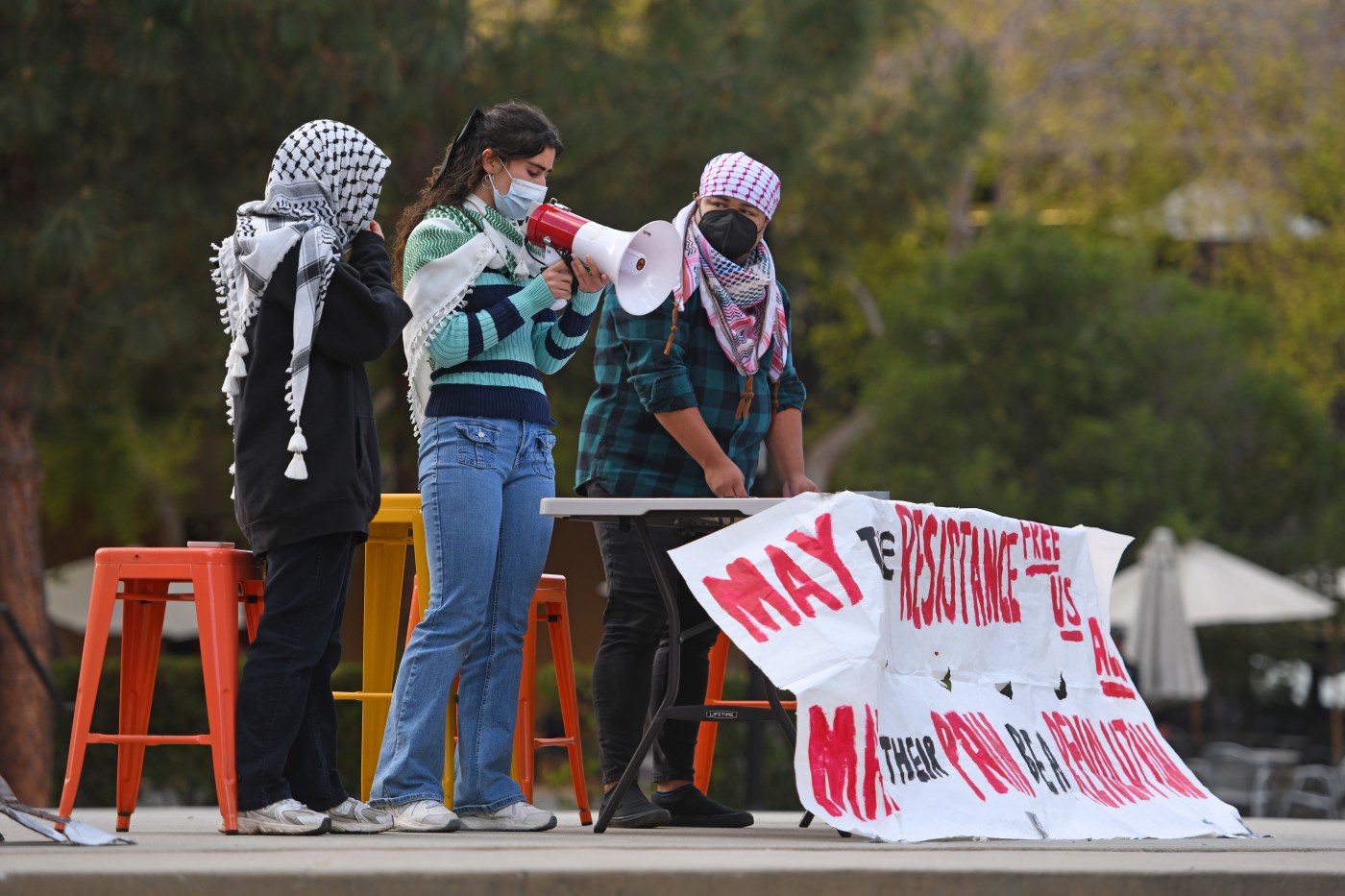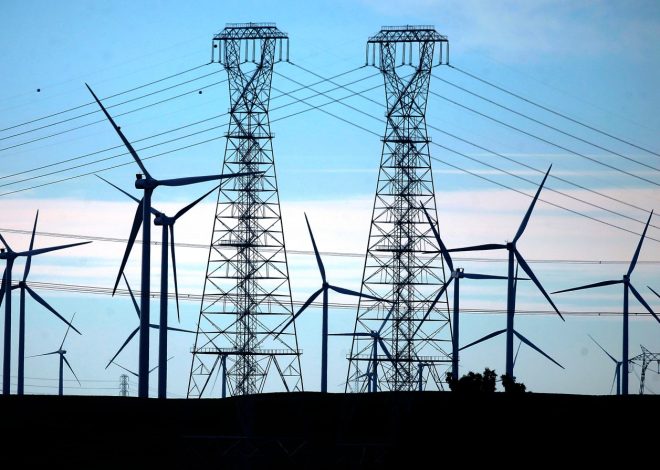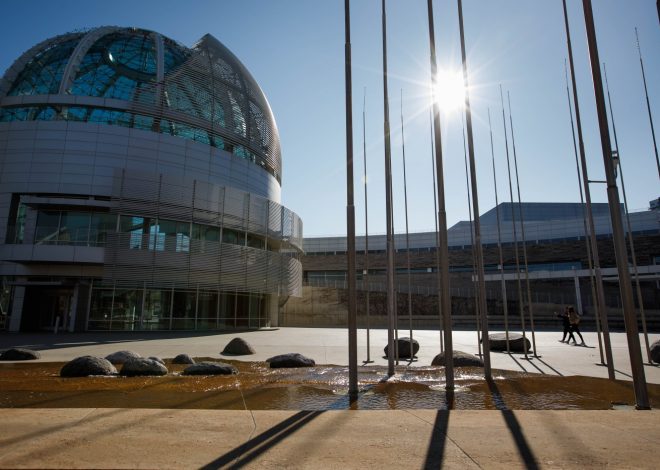
Stanford students rally in support of students facing disciplinary action for staging sit-in
STANFORD — Close to 50 student protestors gathered Monday to hold a “people’s tribunal” ahead of Stanford University’s decision about possible disciplinary action against 13 pro-Gaza protestors who were arrested in June after barricading themselves inside the president’s office.
Students gave speeches and denounced school leaders at the public event Monday afternoon, complete with a cutout of Stanford President Jonathan Levin’s head on a cardboard body in a chair with Palestinian flags and signs in red, black and green secured to the wall behind them. The mock trial had two “prosecutors” followed by speeches from “witnesses” as students watched, most wearing keffiyehs around their heads or necks and with masks covering their faces.
“The students wanted to demonstrate that they’re putting Stanford on trial because they believe that it is Stanford who is guilty of … monetarily aiding and abetting Israel” through not divesting, said Emily Wilson, a member of the class of 2026 who serves as a spokesperson for the coalition of student organizations hosting the tribunal.
The thirteen students were arrested at Stanford on June 5 after they barricaded themselves in the office to protest the university’s refusal to negotiate with the organizers of a student encampment, called the People’s University for Palestine. During the protest, some of the university’s historic sandstone buildings were defaced with graffiti. The students put up signs “renaming” Stanford University President Richard Saller’s office “Dr. Adnan’s Office,” after a Palestinian physician who died in an Israeli jail. The group called itself an “autonomous group of Stanford University students.”
Stanford University officials did not respond to multiple requests for comment on Monday.
Following the protest, the students were immediately suspended and seniors were barred from graduating. The protestors have not been charged. The Santa Clara County District Attorney’s Office will review the case when they receive it and make a decision about whether to charge the protestors, said Sean Webby, director of communications for the DA’s office.
A student protestor adjusts a cardboard cutout of Stanford president Jonathan Levin during a mock trial held at Sanford University in Palo Alto, Calif., on Monday, Oct. 28, 2024. Students gathered to protest as they await the results of whether Stanford will or will not sanction the 13 students who staged a sit-in in the president’s office in June. (Jose Carlos Fajardo/Bay Area News Group)
Those arrested included 12 pro-Palestine activists and a student reporter from the Stanford Daily, the campus newspaper reported. Santa Clara County Sheriff’s deputies assisted Stanford’s public safety officers in removing the students from the president’s office in the heart of the Stanford campus.
Stanford said in June that discipline for the occupying students would be severe. In a letter, 26 free speech organizations urged the Santa Clara County District Attorney to not file charges against the student journalist.
“Banning from campus is a very harsh thing that they rarely do,” Wilson added. Wilson expressed concern that the student protestors banned from campus as part of their suspension lost access to their housing and were unable to access health care through the university.
Wilson added that she is not sure what impact Stanford’s decision will have on student protests going forward, adding that it is currently “wait and see” for pro-Palestine protestors.
“We want to see how far Stanford’s responses to the student advocacy is willing to go,” she said. “I think that if students deem that an escalation is necessary, I think it would be a matter of assessing the risk and whether or not they would be willing to take it.”
A Ph.D student who declined to share his name said at the event Monday that the “damper is already there” on student protesting, adding that there is “immense risk” to speak out.
“Everyone is aware that there are huge risks already, and this is just another drop in the bucket,” he said. “If I get in trouble or whatnot, it’s a slap on the wrist compared to other human beings who are suffering so, so much more.”
Pro-Palestinian demonstrators occupy a part of Stanford University’s White Plaza in Stanford, Calif., on Thursday, May 2, 2024. The demonstrators have been occupying the area since last Thursday urging the university to divest from Israel and demanding a permanent cease-fire in the war in Gaza. (Dai Sugano/Bay Area News Group)
In April, students set up an encampment at White Memorial Plaza, with students students pitching tents, surrounding the square with hand-painted signs and hosting events such as teach-ins.
Protesters at the camp demanded that Stanford divest from companies and other entities supporting Israel’s military actions in Gaza. They also asked the university to issue a statement condemning Israel and calling for a ceasefire.
Following the students’ arrests, the encampment was forcibly disassembled.
On October 15, the Stanford Board of Trustees declined to disclose its financial ties to companies potentially linked to the Israel Defense Forces or to divest from them.
Some students attending the rally expressed frustration that Stanford was considering disciplinary action against the protestors.
“Protesting horrific violence should not merit a felony, should not merit expulsion from campus if you haven’t hurt anybody or destroyed anything major,” said Arielle Johnson, a postdoctoral researcher at Stanford who attended the rally. “What’s being proposed as a punishment for these students is out of proportion with what they did and the good spirit in which they did it.”


